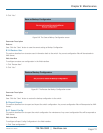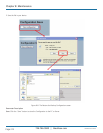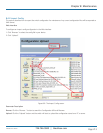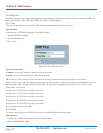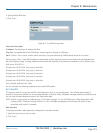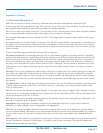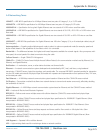
724-746-5500 | blackbox.com
724-746-5500 | blackbox.com
Page 219
LGB5028A User‘s Manual
Appendix A: Glossary
DoS: DoS is an acronym for Denial of Service. In a denial-of-service (DoS) attack, an attacker attempts to prevent legitimate users
from accessing information or services. By targeting network sites or network connections, an attacker may be able to prevent
network users from accessing email, web sites, online accounts (banking, etc.), or other services that rely on the affected
computer.
Dotted Decimal Notation: Dotted Decimal Notation refers to a method of writing IP addresses using decimal numbers and dots
as separators between octets. An IPv4 dotted decimal address has the form x.y.z.w, where x, y, z, and w are decimal numbers
between 0 and 255.
DSCP: DSCP is an acronym for Differentiated Services Code Point. It is a field in the header of IP packets for packet classification
purposes.
EEE: EEE is an abbreviation for Energy Efficient Ethernet defined in IEEE 802.3az.
EPS: EPS is an abbreviation for Ethernet Protection Switching defined in ITU/T G.8031.
Ethernet Type: Ethernet Type, or EtherType, is a field in the Ethernet MAC header, defined by the Ethernet networking standard.
It is used to indicate which protocol is being transported in an Ethernet frame.
FTP: FTP is an acronym for File Transfer Protocol. It is a transfer protocol that uses the Transmission Control Protocol (TCP) and
provides file writing and reading. It also provides directory service and security features.
Fast Leave: Multicast snooping Fast Leave processing allows the switch to remove an interface from the forwarding-table entry
without first sending out group-specific queries to the interface. The VLAN interface is pruned from the multicast tree for the
multicast group specified in the original leave message. Fast-leave processing ensures optimal bandwidth management for all
hosts on a switched network, even when multiple multicast groups are in use simultaneously. This processing applies to IGMP and
MLD.
HTTP: HTTP is an acronym for Hypertext Transfer Protocol. It is a protocol that is used to transfer or convey information on the
World Wide Web (WWW). HTTP defines how messages are formatted and transmitted, and what actions Web servers and
browsers should take in response to various commands. The other main standard that controls how the World Wide Web works
is HTML, which covers how Web pages are formatted and displayed.
Any Web server machine contains, in addition to the Web page files it can serve, an HTTP daemon, a program that is designed to
wait for HTTP requests and handle them when they arrive. The Web browser is an HTTP client, sending requests to server
machines. An HTTP client initiates a request by establishing a Transmission Control Protocol (TCP) connection to a particular port
on a remote host (Port 80 by default). An HTTP server listening on that port waits for the client to send a request message.
HTTPS: HTTPS is an acronym for Hypertext Transfer Protocol over Secure Socket Layer. It is used to indicate a secure HTTP
connection.
HTTPS provides authentication and encrypted communication and is widely used on the World Wide Web for security-sensitive
communication such as payment transactions and corporate logons.
HTTPS is really just the use of Netscape's Secure Socket Layer (SSL) as a sublayer under its regular HTTP application layering.
(HTTPS uses Port 443 instead of HTTP Port 80 in its interactions with the lower layer, TCP/IP.) SSL uses a 40-bit key size for the
RC4 stream encryption algorithm, which is considered an adequate degree of encryption for commercial exchange.
ICMP: ICMP is an acronym for Internet Control Message Protocol. It is a protocol that generated the error response, diagnostic, or
routing purposes. ICMP messages generally contain information about routing difficulties or simple exchanges such as time-stamp
or echo transactions.
IEEE 802.1x: IEEE 802.1x is an IEEE standard for port-based Network Access Control. It provides authentication to devices
attached to a LAN port, establishing a point-to-point connection or preventing access from that port if authentication fails. With
802.1x, access to all switch ports can be centrally controlled from a server, which means that authorized users can use the same
credentials for authentication from any point within the network.



